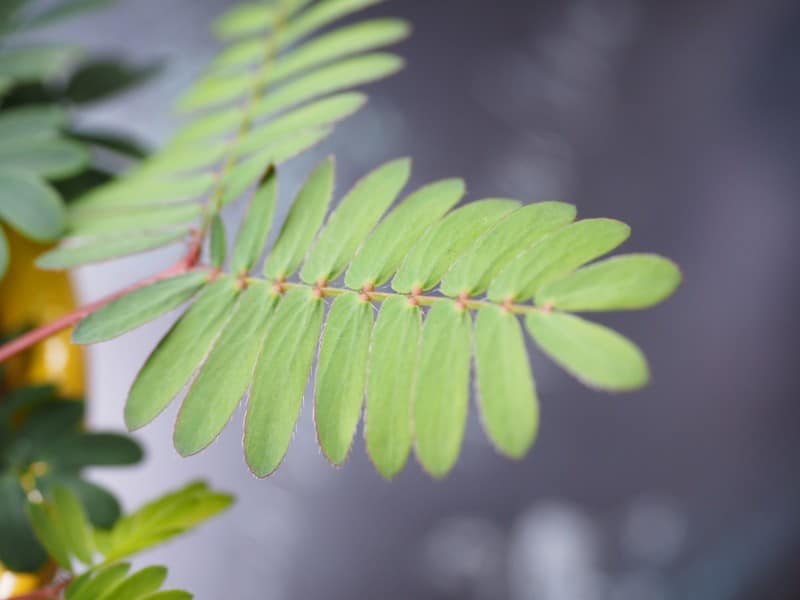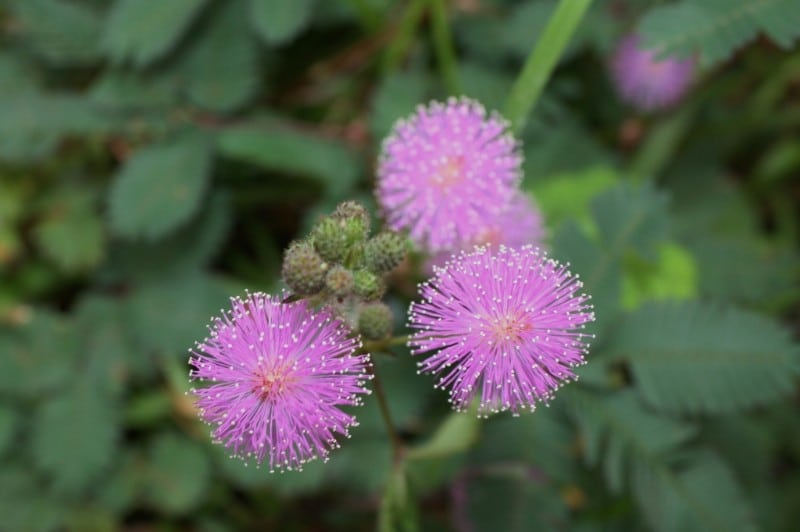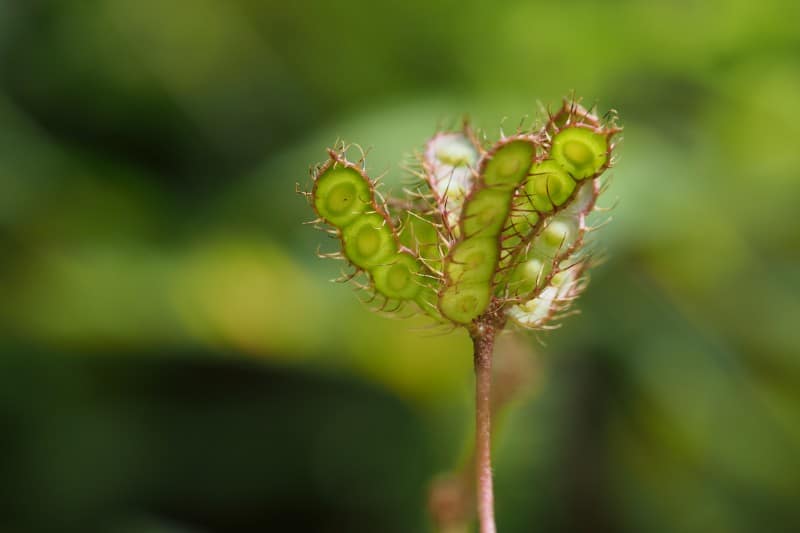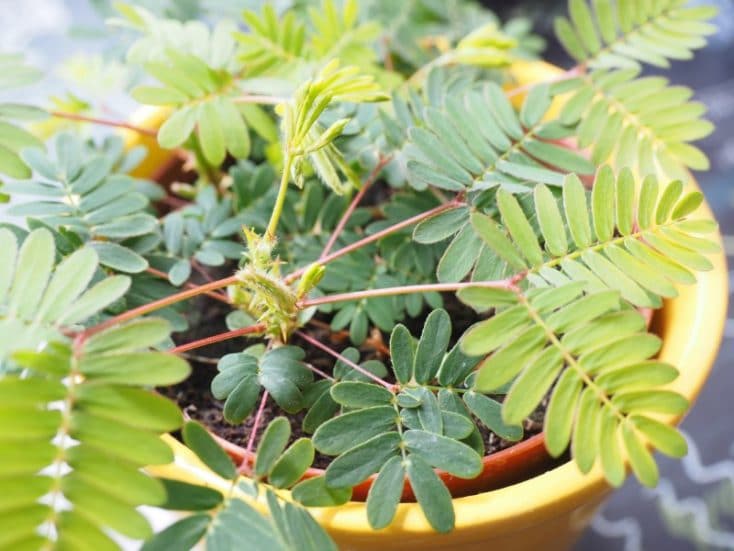Mimosa pudica, commonly known as the sensitive plant, is a wonder of nature. While it has a lot to offer as a houseplant, with its feathery compound leaves and pretty powder puff flowers, it’s the amazing leaf action that makes this tropical plant so intriguing: At the slightest touch, the leaflets will quickly close together!
Caring for this captivating houseplant isn’t difficult, and this article will walk you through everything you need to know to grow the sensitive plant indoors so you can enjoy this botanical marvel in your own home.
Sensitive Plant Care Summary:
- Soil: Well-draining loamy soil
- Container: Medium sized pot with drainage
- Light: Bright light, some direct sunlight
- Temperature: 60-85 F (16-30 C)
- Humidity: High
- Watering: Consistently moist but not soggy
- Fertilizing: Diluted high-potassium liquid fertilizer every two weeks
- Propagation: Seeds
Before going into the details of how to care for a sensitive plant, an introduction to Mimosa pudica and the fascinating phenomenon of nastic movement that it exhibits is in order. After learning the details about each of the care issues summarized here, you’ll find answers to further questions about the sensitive plant and its care that haven’t been previously covered in any of the sections.

Introduction To The Sensitive Plant
Native to tropical South and Central America, the sensitive plant is a creeping herb or shrub with thorny stems and branches that belongs to the Fabaceae family of plants, which means it’s related to peas, beans, and legumes.
The plant’s dainty fern-like leaves are made up of matching pairs of oblong-shaped leaflets that have tiny hairs on their surfaces as well as along the margins. These hairs are very sensitive to touch, motion, and temperature, and when stimulated, each pair of leaflets close together in a fan-like motion.
The sensitive plant produces clusters of delicate, pale pink or lavender flowers in mid-summer to early autumn that resemble fluffy pompons, due to hundreds of fine filaments that make up these small, globular blooms. These develop into flat pods containing between one and six seeds each.
While the sensitive plant often grows as a perennial in nature, it’s usually treated as an annual when grown as a houseplant because the plant tends to deteriorate after blooming. But if you harvest the seeds, it’s quick and easy to grow new plants from them.
The scientific name Mimosa pudica is derived from the Greek word for “mime” and the Latin word for “bashful,” in reference to the way the leaves react to stimuli as if the plant has the consciousness to be shy and physically retract itself when perturbed.
Common names for Mimosa pudica include:
- Sensitive plant
- Action plant
- Humble plant
- Sensible plant
- Shame plant
- Touch-me-not
- Sleepy plant
Nastic Movement Of Sensitive Plant Leaves
The remarkable leaf action of the sensitive plant, known as “nastic movement,” is fascinating to children and adults alike. Nastic movement is the non-directional mechano-sensory response to stimuli, and it’s completely different from common plant growth movements (tropisms) that depend on the direction of a stimulus such as light or water and that permanently change the plant as it develops and matures.
The sensitive plant actually exhibits two types of nastic movement. It is best known for its seismonastic (or thigmonastic) movement, which is when the leaflets close together in response to mechanical stimuli such as touch, heat, air motion, or shaking. Since the leaflets close up fast enough to observe in real time, this ability is also referred to as “rapid plant movement.” The other plant besides Mimosa pudica that is famous for its ability to move rapidly is the carnivorous Venus flytrap.
Less well known is the sensitive plant’s nyctinastic movement, which is a response to daily light and temperature triggers that occur at dusk and dawn. This folding in of leaves at night and reopening in the morning is controlled by the plant’s phytochromes, or light receptors, along with its circadian clock – so the plant appears to be going to sleep every night and waking up again in the mornings.
As for the mechanism that’s responsible for the closing and reopening motion of the leaflets, sensitive plant leaves have a hinge-like structure called a “pulvinus” containing specialized motor cells that work in opposition to each other.
The plant reacts to stimuli by releasing chemicals that cause water to flow out of the motor cells on one side the pulvinus and into matching cells on the opposite side. This results in changes of turgor pressure, which is the force of water and other cell contents that pushes against the cell walls of plants, causing those cells to collapse and expand, respectively, thus squeezing the leaflet shut.
When triggered, this motor impulse passes along the rachis, or central shaft of the leaflet, progressively closing each blade in a mesmerizing fan-like motion. If left undisturbed, the leaflet will slowly reopen after a few minutes.
Check out the video below for a great demonstration of the movement of sensitive plant leaves.
Best Potting Mixture For The Sensitive Plant
Now that you understand what makes this amazing plant so unique and intriguing, it’s time to learn how to care for the sensitive plant, starting with what soil you should use.
Mimosa pudica requires soil that can hold enough water to remain consistently moist while providing good aeration and drainage to prevent root rot caused by compacted or soggy soil.
If you would like to make your own sensitive plant potting soil, you can create a good mixture by using two parts loamy soil, two parts peat moss, and one part builder’s sand or perlite. Or, you can simply look for a commercial potting soil that has similar proportions.
Choosing A Pot For Your Sensitive Plant
Since you don’t want the soil your sensitive plant is growing in to get soggy, you need to use a pot with drainage holes. These plants do best when their roots are somewhat confined, so choose a pot that fits the size of the plant. Use a small 3-inch (8-cm) pot for seedlings, and once it is well established, repot it in a 5-inch (13-cm) pot.
Because the sensitive plant likes to have its potting mixture kept moist at all times, it is a suitable plant for growing in self-watering pots.
Bright Lighting For The Sensitive Plant
Sensitive plants need plenty of bright light. If the plant doesn’t receive enough light, the leaves may close up and it won’t be able to produce blooms.
Set your plant in a sunny window that receives some direct sunlight. An east-facing window that gets morning sunlight is ideal for Mimosa pudicahouseplants. If the best light source is a west-facing window, it’s best to place the plant back from the window by 1-3 feet (30-90 cm), while a plant in a south-facing window (north-facing in the Southern Hemisphere) should be set back by about 5 feet (1.5 meters).
Another way to achieve proper lighting for the sensitive plant is to use full-spectrum fluorescent grow lighting that provides more than 300 foot-candles of light.
Temperature Range For Healthy Sensitive Plant Growth
Sensitive plants need a temperature range of 60-85 F (16-30 C) to germinate, sustain healthy growth, and produce flowers. This range matches up with the typical temperatures found in most indoor environments, so it’s likely that providing the right amount of warmth for your plant won’t be a problem. Just don’t forget that a plant set near a window may experience a nighttime drop in temperature that could weaken the plant and prohibit it from blooming.

Sensitive Plants Need High Humidity
While many houseplant that originate in the tropics do just fine in the dryer indoor environments that are typical of modern homes and offices, the sensitive plant is one that needs a high level of humidity to thrive.
Provide this vital element for Mimosa pudicaby placing a humidifier nearby and misting the plant occasionally. Or, instead of using a humidifier, you can create a simple humidity tray by placing pebbles in a small tray, filling it with water, and setting the potted plant on top of the pebbles, making sure the pot is sitting above the water level such that the water won’t get wicked up into the potting soil and cause it to become soggy.
How To Water A Sensitive Plant
The sensitive plant prefers that its potting mixture is kept consistently moist. To achieve this, water the potting soil thoroughly and allow the excess moisture to drain out of the pot. Then, the next time you should water will be after the soil has dried out a
The amount of time between waterings will vary according to numerous factors, such as the time of year, the weather conditions, and the size of the plant.
Fertilizer For The Sensitive Plant
Like many other members of the Fabaceae family of plants, the sensitive plant is capable of nitrogen fixation, which means it can convert atmospheric nitrogen that is unavailable to plants into ammonia and other nitrogen compounds that it can use. In nature, this plant tends to be found in nutrient-poor soils. So it only requires half-strength liquid fertilizer every two weeks during the spring-summer growing season.
A high-potassium fertilizer such as tomato plant fertilizer is recommended for the sensitive plant since its nastic movement requires energy. Also, potassium is a key nutrient for the generation, movement, and storage of carbohydrates that fuel all plant activity, and potassium ions are one of the main chemicals the plant uses to trigger the leaflets to close themselves up.
Sensitive Plant Propagation
Although it is possible to take stem cuttings to propagate new sensitive plants, growing plants from seed is so quick and easy that it is the most common method of producing new plants.
If you are purchasing sensitive plant seeds, be sure to source them from a reputable grower. If you already have a plant, simply allow the pods to mature and dry out on the plant before collecting the seeds from them.
Seeds should be planted in the springtime, unless you are using artificial lighting and temperature control, in which case you can begin germinating your seeds at any time of the year.
Mimosa pudica seeds have a tough, brown-colored outer coating. They are more likely to germinate if you weaken this coating. Do this by placing them in a bowl of warm water and allowing them to soak for a few hours before planting.
The seeds should be planted in seed compost that’s been moistened by watering thoroughly and then allowing the excess water to drain out. You can make an excellent seeding mixture with 2 parts compost, 2 parts coconut coir fiber or well-rotted leaf mold, and 1 part perlite or sand.
Place the seeds on the surface of the potting mixture and then just barely cover them with a light layer of soil. Since the seeds don’t always germinate, it’s best to plant extras. So you can plant two or three seeds in the same small-sized pot or plant multiple seeds in a seed tray.
After planting, be sure to place the seeds in a location where they will receive bright light and temperatures of at least 65-70 F (18-21 C). This is very important because the seeds won’t come out of dormancy and germinate without these warm temperatures. If your indoor environment is too cool and/or dry, create a mini-greenhouse by covering the seedbed with clear plastic, removing it as soon as you see the first seedling appear.
To water the seeds, check the potting mixture regularly and never allow it to dry out, so the roots have consistent moisture without being waterlogged.
If you soak your seeds and give them plenty of light and warmth, sensitive plant seeds can germinate in less than one week, while they may take up to four weeks in less ideal conditions. You’ll want to snip away any weaker seedlings that appear, keeping the strongest plant to nurture to maturity. Once this plant is established in the small starter pot or seed tray, repot it in a medium sized (5 inches, 13 centimeters) pot.

What Pests Or Diseases Is The Sensitive Plant Susceptible To?
Sensitive plants grown as houseplants tend to be unbothered by most common pests, aside from spider mites. Keep a lookout for these tiny insects, which may appear as small red dots or be detected by feeling for a gritty texture on the plant leaves, and wipe away any that you find with a moist cloth.
When it comes to diseases, the high humidity required for this plant makes it prone to fungal diseases. To prevent these problems, place a soft-blowing fan near the plant to ensure good air circulation in the area.
Is The Sensitive Plant Poisonous?
According to both the UC Division of Agriculture and Natural Resources and the UConn Home & Garden Education Center, the sensitive plant is considered safe and nontoxic for people and pets.
How Long Does A Sensitive Plant Take To Grow?
In tropical climates, sensitive plants live for two or more years, whereas in temperate climates, they tend to behave more like annuals, declining after they produce blooms in the summer. When grown as indoor houseplants, it’s best to treat them as an annual and allow them to die off after collecting the seeds, since it’s so easy to propagate new plants from those seeds.
Should I Treat My Potted Sensitive Plant As A Creeping Herb Or A Shrub?
The sensitive plant is both a creeping herb and a shrub in the sense that the stem tends to grow erect at first, but will eventually fall down and grow along the ground as it ages. To contend with this trailing habit, consider placing a trellis in the pot with your plant for support.
Do Sensitive Plants Need Pruning?
Regular pruning will keep your sensitive plant full and prevent it from looking leggy as its stems and branches begin spreading out with age.
Can I Grow The Sensitive Plant Outdoors?
While the sensitive plant is easy to grow as a houseplant indoors, it won’t thrive outdoors unless it’s in a tropical or subtropical climate that receives plenty of sunlight, humidity, and heat.
Even if you are located in a place that has the perfect climate for the sensitive plant, there is a very important reason not to grow these plants outdoors: Mimosa pudica is an aggressive plant that is considered to be an invasive weed in many areas of the world, and it’s very hard to get rid of this thorny creeper once it takes hold.
Why Do The Leaves Of Sensitive Plants Close?
Why the sensitive plant evolved the ability to close up its leaves remains a mystery, although researchers theorize that the
Botanists are a bit confounded, though, because this rapid plant movement requires a lot of energy as well as interfering with photosynthesis. The reason the sensitive plant closes its leaves at night and “goes to sleep” is also a mystery.
I hope you have enjoyed this article about the s

